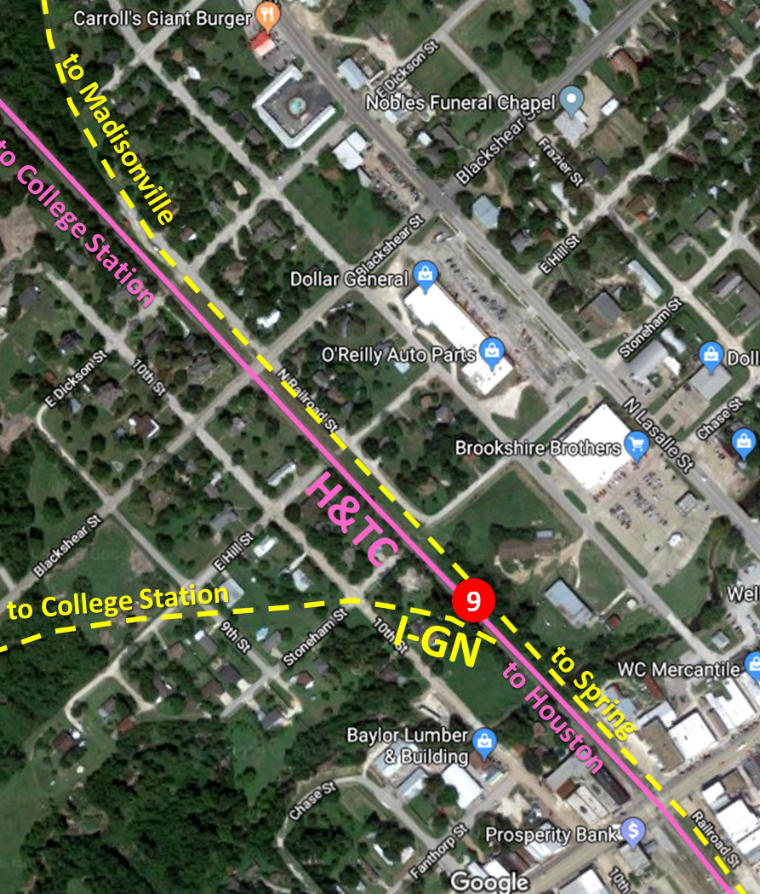Texas Railroad History - Towers 9 and 41 - Navasota
Crossings of the International-Great Northern, Houston & Texas
Central, and Gulf, Colorado & Santa Fe
railroads

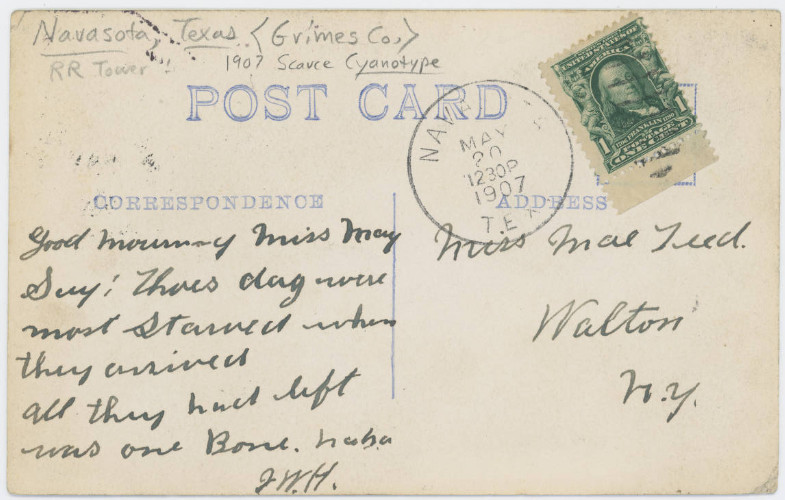
Left and Above: Mailed from Navasota on May 20, 1907,
the cyanotype photo on the front of this post card is identified on the back as "Navasota, Texas
<Grimes Co.> R R Tower". There were two railroad towers in Navasota;
this one
was Tower 9 located a short distance north of downtown at a crossing of the
Houston & Texas Central (H&TC) Railway and the International & Great Northern
(I-GN) Railroad. Because of the "fish scale" pattern on the upper story, the
tower resembles many that were built by H&TC's owner, Southern Pacific (SP);
this pattern was used on virtually every SP tower in Texas (e.g.
Tower 17, Tower 26 and
Tower 115 among many others.) But other railroads
sometimes used this same pattern (e.g. Tower 4,
Tower 28), and the height of the pattern area on
Tower 9 is noticeably smaller than typically found on SP towers. The I-GN was
the second railroad at this crossing, arriving about the time that the new
interlocker law took effect in 1901. For new crossings, the law gave the second
railroad full responsibility for the capital outlay for the tower and its
interlocking plant, thus it's likely that Tower 9 was funded and built by I-GN.
This is reinforced by the fact that I-GN agreed to be responsible for all
staffing and maintenance for Tower 9.
The post card view of Tower 9
is to the north showing the staircase on the south side of the structure.
Visible behind the tower on the right side is the I-GN track to Madisonville. Passing to the left of the
tower is the H&TC main line to College Station. The track that crosses the H&TC main line on the diamond in the
foreground is the I-GN line to College Station. This crossing was the reason for
the Tower 9 interlocker which was approved for operation by the Railroad
Commission of Texas (RCT) on June 16, 1903. Also of note: there is no external
identification visible on the tower. In particular, there is no white
rectangular tower number placard as was prevalent on almost every two-story
interlocking tower in Texas (see the tower reference links above for examples.)
This is probably due to the early date of the photo which likely preceded
RCT's
issuance of a regulation mandating a particular type and placement of tower number signs. (The
post card was mailed in
1907, but the photo could have been as early as 1903.) Such regulation is
presumed to have existed at some point based on the commonality of white
placards with black numerals on Texas interlocking towers built by various
railroads. (post card from the John Miller Morris collection,
DeGolyer Library, Southern Methodist University, hat tip Dennis Hogan)

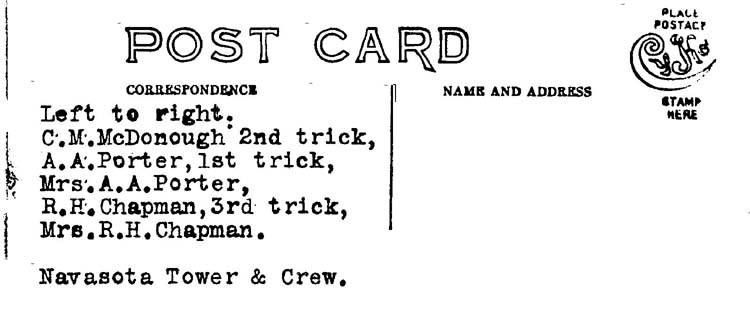 Left
and Above: Another
Navasota post card with an interlocking tower, this one was not mailed so there
is no postmark date. This structure can be identified as Tower 41 because it was
located near the Union Station passenger depot (seen in the background) used by the H&TC
and the Gulf, Colorado & Santa Fe (GC&SF) Railway. The tower sat
adjacent to the crossing of these two railroads near downtown Navasota, with the
H&TC line to College Station visible beside the tower. The photographer is
probably standing on or near the Santa Fe tracks, which crossed the H&TC at an
acute angle and passed behind (to the left of) Union Station. This tower also has the fish
scale pattern, but unlike Tower 9, the pattern height matches that of the typical SP
tower, and there are no known Santa Fe towers that
exhibited this feature. Though Santa Fe was the second railroad at this
crossing, it had arrived long before interlocking towers were addressed by Texas
law. Thus, the new interlocker law required Santa Fe and SP to share the
financial responsibility for the tower. Tower 41 was substantially more
important to SP's main line than it was to Santa Fe's branch line, so it is not
surprising that SP oversaw the design and construction task, with RCT commissioning
accomplished on June 24, 1904. The external sign clearly
reads "NAVASOTA"; other parts of it are illegible although the numeral
'3' appears to be visible. The tower does not have a white tower number placard, and again, this is most likely due to the photo being taken
before the regulation was issued. The clothing of the tower crew certainly
suggests a pre-1907 photo like the Tower 9 image above. (Dennis Hogan
collection)
Left
and Above: Another
Navasota post card with an interlocking tower, this one was not mailed so there
is no postmark date. This structure can be identified as Tower 41 because it was
located near the Union Station passenger depot (seen in the background) used by the H&TC
and the Gulf, Colorado & Santa Fe (GC&SF) Railway. The tower sat
adjacent to the crossing of these two railroads near downtown Navasota, with the
H&TC line to College Station visible beside the tower. The photographer is
probably standing on or near the Santa Fe tracks, which crossed the H&TC at an
acute angle and passed behind (to the left of) Union Station. This tower also has the fish
scale pattern, but unlike Tower 9, the pattern height matches that of the typical SP
tower, and there are no known Santa Fe towers that
exhibited this feature. Though Santa Fe was the second railroad at this
crossing, it had arrived long before interlocking towers were addressed by Texas
law. Thus, the new interlocker law required Santa Fe and SP to share the
financial responsibility for the tower. Tower 41 was substantially more
important to SP's main line than it was to Santa Fe's branch line, so it is not
surprising that SP oversaw the design and construction task, with RCT commissioning
accomplished on June 24, 1904. The external sign clearly
reads "NAVASOTA"; other parts of it are illegible although the numeral
'3' appears to be visible. The tower does not have a white tower number placard, and again, this is most likely due to the photo being taken
before the regulation was issued. The clothing of the tower crew certainly
suggests a pre-1907 photo like the Tower 9 image above. (Dennis Hogan
collection)
Navasota is one of the oldest
railroad towns in Texas, becoming a major rail junction with the
intersection of three main lines. First to arrive was the Houston & Texas
Central (H&TC) Railway in 1859,
building north out of Houston, the first major north/south railroad in
Texas. The Civil War disrupted progress, but by 1873, the line had been
completed north to the Red River. The H&TC was eventually
acquired by Southern Pacific (SP) and integrated into the Texas & New
Orleans (T&NO) Railroad, SP's operating railroad for Texas and
Louisiana. H&TC's original route remains in active use through Navasota,
today operated by SP's successor, Union Pacific (UP).
In 1878, the newly
chartered Central & Montgomery (C&M) Railway built 27 miles of track
between Navasota and Montgomery to provide timber interests in Montgomery
County with rail access via connection to the H&TC at Navasota. In
1882, the Gulf, Colorado and Santa Fe (GC&SF) Railway initiated plans to
build a lengthy branch line east from their main line at Somerville to
tap the growing east Texas timber industry. The initial Somerville to Navasota
segment was built in 1883. Santa Fe then acquired the C&M since it
would save 27 miles of eastward construction. Eighteen miles of track was
then built from Montgomery to Conroe which was reached
in 1885. This line continues east beyond Conroe and
remains in service, now owned by Burlington Northern Santa Fe (BNSF).
In 1902, the International
& Great Northern
(I-GN) Railroad passed through
Navasota as it constructed a main line from Houston to
Ft. Worth. In Navasota, the I-GN paralleled the other two railroads
near downtown with
the Santa Fe line in the middle, the I-GN to the east and the
H&TC to the west. In 1904, the I-GN constructed a branch line from
Navasota to Madisonville. The I-GN came
under the ownership of the Missouri Pacific (MP) Railroad in 1925. Under
MP management, the Madisonville line was abandoned in 1944. In 1956, the
I-GN was formally merged into MP as part of a financial reorganization out
of receivership. In 1965, SP and MP agreed to
begin sharing the more direct SP line to
College Station and abandon the MP line
north of Tower 41. This eliminated the need for Tower 9. The MP
tracks through downtown were merged onto the SP main at Tower 41 and the
former MP track from downtown to Tower 9 was removed. In 1982, MP
was bought by UP into which it became legally and fully merged in 1997.

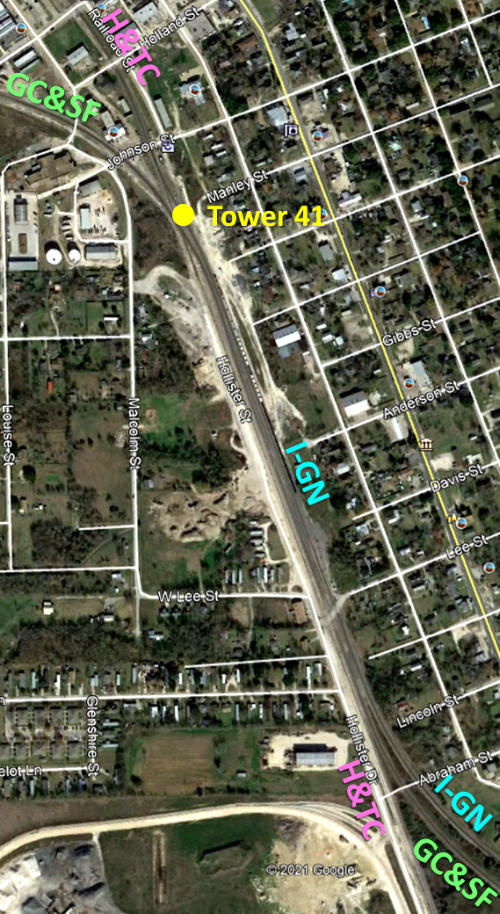 Above: The Office of Chief Engineer of the Missouri -
Kansas - Texas (MKT) Railroad maintained track charts for most major rail
junctions in Texas, regardless of whether the MKT passed through them. This 1915
chart for Navasota has been annotated to show the tower locations, which were
approximately a half mile apart. Note that I-GN maintained a separate passenger
station ("I&GN Station") and did not share the "Union Station" (H&TC and Santa
Fe.) Providing I-GN trains with the means to cross two main tracks to reach Union Station was not considered viable. The
northbound H&TC is line is marked as heading for Hearne, but College Station and
Bryan were along the route and closer than Hearne. Similarly, the I-GN line to
the west would curve north and proceed to College Station and Bryan long before
reaching Valley Junction. Singleton is listed as the destination for the I-GN
line to the north instead of Madisonville. Singleton was certainly closer than
Madisonville, but it was tiny, significant only because it was the site of a
non-interlocked I-GN crossing of the Trinity &
Brazos Valley (T&BV) Railway at grade. Despite the
presence of two railroads, Singleton's population never exceeded 150. (track
chart courtesy of Ed Chambers) Right: This recent Google Earth satellite image
has been annotated to show the rail line heritage that remains active in
Navasota. Through the center of town, the three lines run parallel: the H&TC on
the west, the Santa Fe in the middle and the I-GN to the east. At Tower 41, the
Santa Fe crosses over the H&TC and proceeds west to Somerville. North of Tower
41, the I-GN line originally remained parallel to the H&TC until Tower 9 was
reached (off the top of the image) where the I-GN crossed over the H&TC to
proceed northwest on a circuitous route to College Station. A switch south of
Tower 9 gave access to the MP line to Madisonville which continued past Tower 9
and remained parallel to the H&TC for a quarter mile before curving northeast to
head for Madisonville. After the abandonment of the MP line from Tower 9 to Tower 7 in 1965, a switch was added near Tower
41 so that MP could share the SP track north of Tower 41 all the way to College
Station. North of Tower 41, the MP tracks were removed to Tower 9, which was
abandoned; its fate has not been determined. Today, these tracks are operated by
BNSF (GC&SF) and UP (H&TC, I-GN).
Above: The Office of Chief Engineer of the Missouri -
Kansas - Texas (MKT) Railroad maintained track charts for most major rail
junctions in Texas, regardless of whether the MKT passed through them. This 1915
chart for Navasota has been annotated to show the tower locations, which were
approximately a half mile apart. Note that I-GN maintained a separate passenger
station ("I&GN Station") and did not share the "Union Station" (H&TC and Santa
Fe.) Providing I-GN trains with the means to cross two main tracks to reach Union Station was not considered viable. The
northbound H&TC is line is marked as heading for Hearne, but College Station and
Bryan were along the route and closer than Hearne. Similarly, the I-GN line to
the west would curve north and proceed to College Station and Bryan long before
reaching Valley Junction. Singleton is listed as the destination for the I-GN
line to the north instead of Madisonville. Singleton was certainly closer than
Madisonville, but it was tiny, significant only because it was the site of a
non-interlocked I-GN crossing of the Trinity &
Brazos Valley (T&BV) Railway at grade. Despite the
presence of two railroads, Singleton's population never exceeded 150. (track
chart courtesy of Ed Chambers) Right: This recent Google Earth satellite image
has been annotated to show the rail line heritage that remains active in
Navasota. Through the center of town, the three lines run parallel: the H&TC on
the west, the Santa Fe in the middle and the I-GN to the east. At Tower 41, the
Santa Fe crosses over the H&TC and proceeds west to Somerville. North of Tower
41, the I-GN line originally remained parallel to the H&TC until Tower 9 was
reached (off the top of the image) where the I-GN crossed over the H&TC to
proceed northwest on a circuitous route to College Station. A switch south of
Tower 9 gave access to the MP line to Madisonville which continued past Tower 9
and remained parallel to the H&TC for a quarter mile before curving northeast to
head for Madisonville. After the abandonment of the MP line from Tower 9 to Tower 7 in 1965, a switch was added near Tower
41 so that MP could share the SP track north of Tower 41 all the way to College
Station. North of Tower 41, the MP tracks were removed to Tower 9, which was
abandoned; its fate has not been determined. Today, these tracks are operated by
BNSF (GC&SF) and UP (H&TC, I-GN).
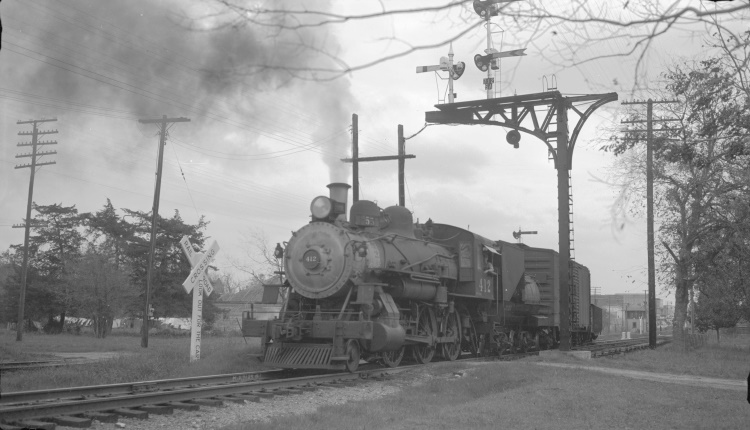
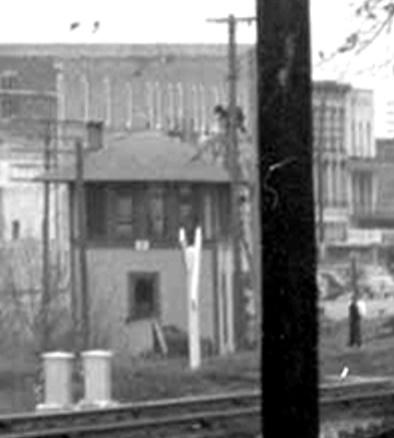
Above Left: This photo from the Denver Public Library
Western History and Genealogy collection was
taken by Robert W. Richardson. It pictures Texas & New Orleans locomotive #412
passing beneath signals in Navasota on December 15, 1946. The I-GN track to
Madisonville is barely visible at the lower left edge. In the background, the
north side of Tower 9 is in view. Under magnification (above
right), the standard white tower number placard is apparent (with
an illegible single digit.) This tower lacks the fish scale pattern
of the original
Tower 9, presumably because an MP design was used when it was rebuilt (as explained below by Richard Mousner.)
September 10, 2008: Richard Mousner discusses Tower 9...
I found the exact location of the 1946
photograph. The photo looks south and was taken as the engine crossed Stoneham
Street northbound. I found the concrete pad and burned off I-beam of the signal
mast in the photo (see photo below). Also, the Schumacher Oil Works can be seen in the background
so I can verify 100% that the tower in the photo is Tower 9. I walked to 9's location. I lined up with
the old I-GN roadbed and the SP tracks and got pretty close but found nothing,
however it was further from the creek than I first thought. My T&NO map shows
Tower 9 in the south right of way of Chase Street, a platted street but never
built.
My good friend Roy Goodwin,
who passed away at the tender age of 93 a couple of years ago related this story
to me. Tower 9 had a trestle that carried the Madisonville Branch which also
accessed the Navasota Creosoting Plant (burned 1980's). With the MP main line to College
Station (bridge remains) and the T&NO main, this was a bad place for a
derailment. The building just south of the tower that later became Goodwin's
Realty once had the wall smashed in by a derailment. One hot summer night, the operator
that manned the tower (Goodwin knew his name) looked up in horror to see a line
of derailed boxcars bearing down on him, the only thing that saved him was that
it was hot, the door was open, and he took a flying dive out of the tower just
as it was destroyed. After the tower was rebuilt, he bid a job on another tower,
and refused to work there again.
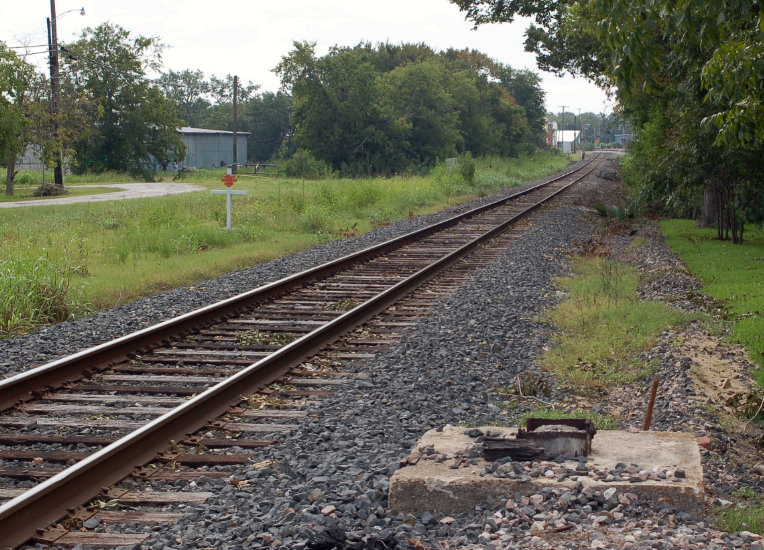
Below Left: This standard SP form was used to document
interlocker functions, usually for the purpose of recording the
agreed allocation of operation and maintenance (O&M) expenses between the
participating railroads. This form for Tower 9 is a modification
of the original as indicated by the handwritten comments in the REMARKS column
noting that changes were made in 1937 and 1941. This form also shows that
despite a roughly balanced function count, 100% of O&M expenses were assigned to
I-GN. While this was not typical, it was the
same practice employed for Tower 7 in College Station between the same two
railroads. Note also that the DATE of October 23, 1901 was only 8 days after the
first hearing ever held by RCT to discuss the new state law mandating
interlockers for major rail crossings that had taken effect a few months
earlier. The significance of this date is explained in more detail in the
discussion for Tower 7. Note also that the "in
service" date in the REMARKS column is two days after the date listed by RCT for
Tower 9's commissioning. (Carl Codney collection)
Below Right: This
image taken from the 1925 Sanborn Fire Insurance Map of Navasota shows Tower
9 in the center, slightly north of where the I-GN line to College Station
crossed over the H&TC line. The right-hand track is the I-GN line to
Madisonville which will parallel the H&TC for a quarter mile before veering off
to the northeast. Magnification shows Tower 9 to be a 2-story "Signal Tower" with an
L-shaped staircase on the south side. This description is consistent with both of the Tower
9 images.
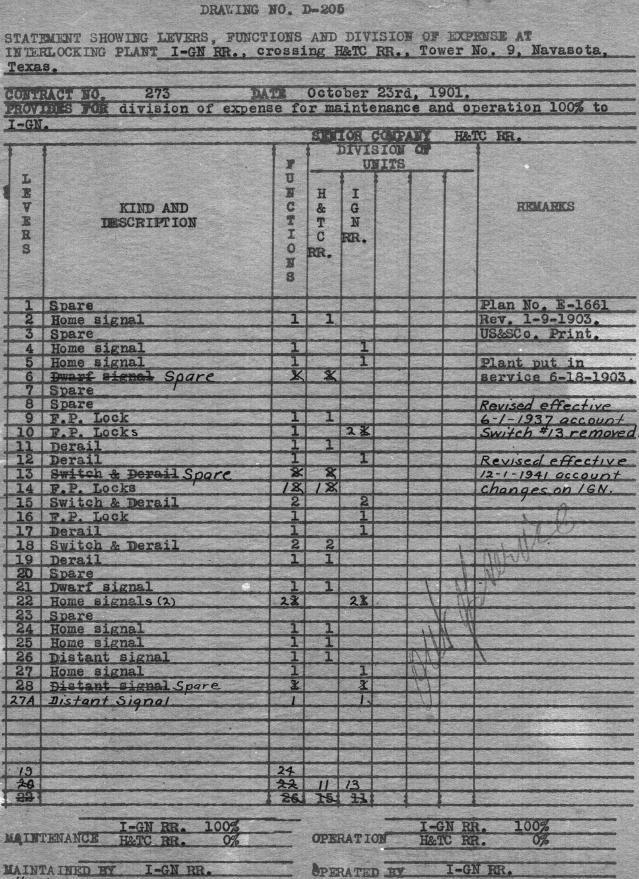
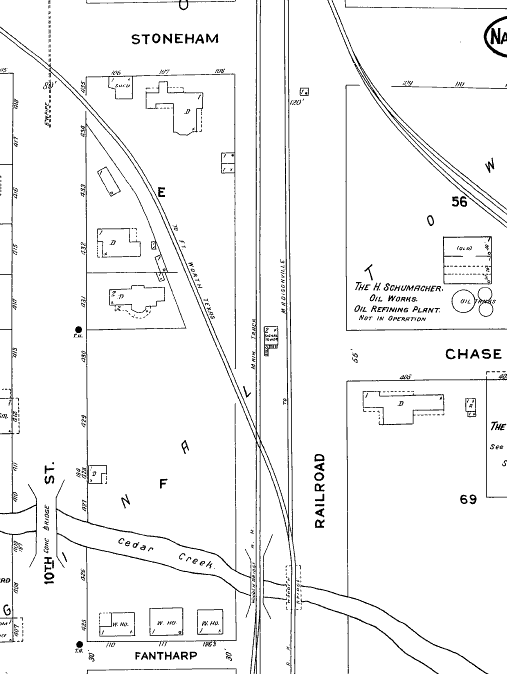

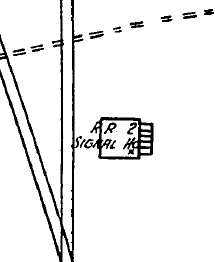
Above Left: This image
taken from the 1925 Sanborn Fire Insurance map of Navasota has been annotated to show Tower 41 at
left center (red circle) located slightly north of where the Santa Fe tracks crossed the H&TC tracks. Magnification (above right)
shows the building to be a 2-story "RR Signal Ho" (House) with the stairs on the
northeast side. Note also the proximity of the joint passenger depot (Union
Station) northwest of the tower.
The postcard photo of "Navasota Tower", with the stairs visible on the
right side of the tower and Union Station in the background, matches what would
be expected based on the Sanborn map.
Richard Mousner provides this story about Tower 41...
Another story concerns my uncle Herb
Doerge born in Navasota in 1910. When he was about 10 yrs. old, his father Albert
took him to the H&TC tower to meet a famous man on the H&TC. As he sat and
watched, this man, with two telegraph bugs going off at he same time, proceeded
to write both messages down at the same time, using his right and left hand and
copying both messages not making a single mistake. He said people would come and
just sit and watch him work...I doubt H&TC paid him extra.
Richard also raises an interesting question about
Tower 41...
Now 41 is going to give you fits
because the maps I have state that Interlocker #41 is in the depot building. The
post card photo of the old tower is definitely about where it should be, because of the
location of the H&TC Depot in the background. My maps are revised 1928. Do you
think 41 was torn down before 1928 and moved to the depot? My maps are the
survey maps and are made from actual surveys on the ground. I used them in my 34 yrs as a land surveyor to locate property along the railroad.
It is certainly possible that Tower 41 was removed
prior to 1928, with the interlocking system moved to an equipment cabinet and
the controls relocated to Union Station. Since Tower 41 was commissioned in
1904, the building may have required some serious maintenance work
by the late 1920s. Rather than continue to maintain it or build a new
tower, the railroads could have decided to relocate the interlocker controls. It was an electric interlocker with 20 functions, a relatively small
number of functions which tends to indicate that the movements it controlled
were neither numerous nor complex. This would imply that an operator may not
have needed direct visual observation of the movements to maintain safety. Track
sensors and other automation (or perhaps the view from the depot) may have been sufficient, making
this a good candidate to be an interlocking controlled from the depot. Whatever
the case, the precise construction, evolution and disposition of Tower 41 is
unknown. What is known, however, is that by 1927, SP was completing the
installation of automatic block signaling on the H&TC line between Houston and
Dallas that passed through Navasota.
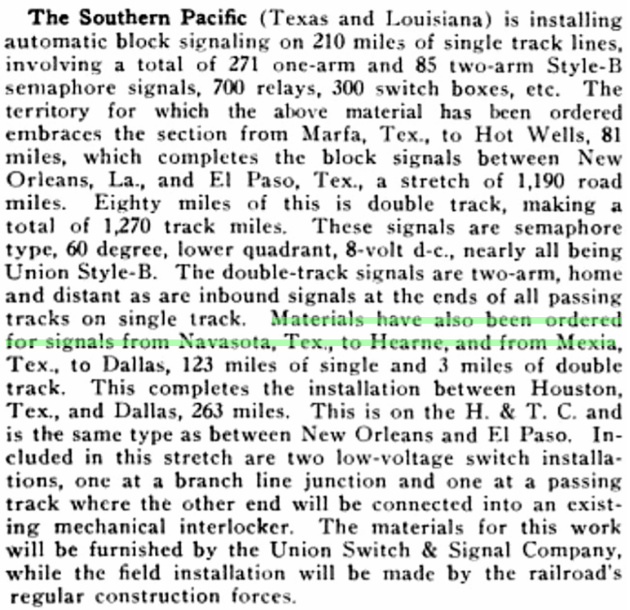 |
Left:
Volume 20, No. 1 issue of Railway
Signaling magazine (January, 1927) contained this news brief
regarding SP's plans for automatic block signals from Navasota to Hearne
and elsewhere (green highlight.) It's easy to speculate that as part of
this upgrade, H&TC and Santa Fe agreed to dismantle Tower 41 and
relocate its remaining controls to Union Station.
Below: At some point,
Tower 41 became an automatic interlocker housed in this cabinet, which
may be too new to be from 1928. Mounted to the post beside the cabinet
are two gray boxes, possibly control buttons or perhaps some
kind of voice communications system which might have served as a means
for manually overriding the governing interlocker
signals. (Jim King photo c.2000)
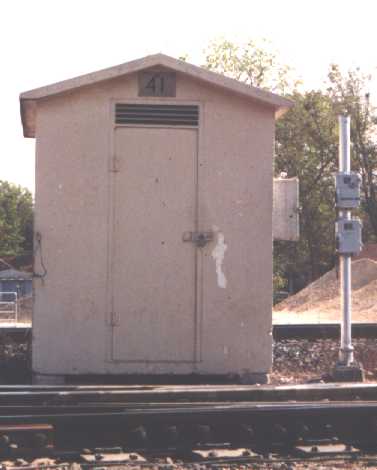 |
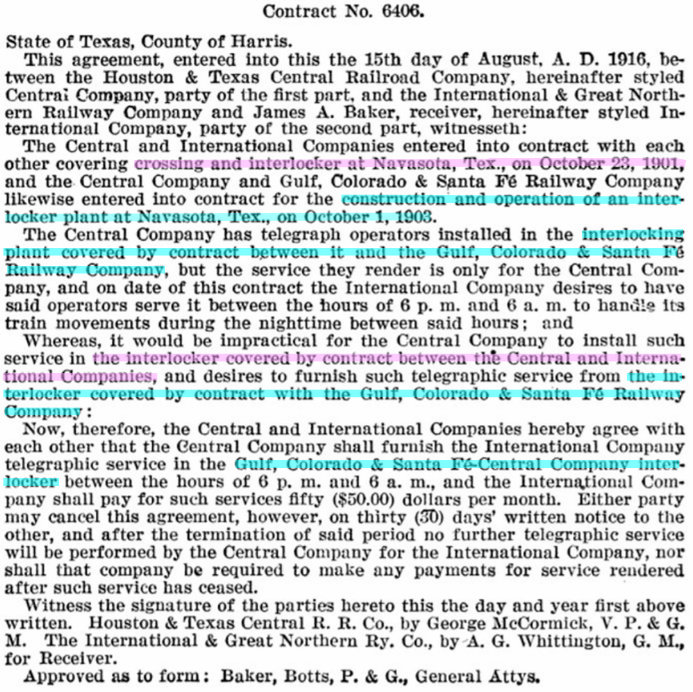 |
Left:
As noted earlier, for track convenience, I-GN had its own passenger
depot across from Union Station. I-GN's depot had an office for a
telegraph operator who received train orders, handed them off to passing
I-GN trains, and reported train arrivals and departures. Unfortunately,
I-GN's traffic levels did not justify staffing the telegrapher position
24-hours a day. The document at left was their solution: a contract to
use H&TC operators in Tower 41 to cover the night shift between 6 pm and
6 am. According to the court case for which this contract was an
exhibit, I-GN's train orders originated from their chief train
dispatcher at Mart (near Waco.) In the evening, orders would be sent to
the H&TC operators in Tower 41 instead of the telegraph office in the
I-GN depot. The contract uses unusual shorthand references for the railroads:
"Central Company" for the H&TC and "International Company" for the I-GN.
References to "James A. Baker" result from I-GN being in receivership at
the time of this contract (1916). Baker was the I-GN's receiver assigned
by the bankruptcy court (and he was also the grandfather of future Secretary of
State, Secretary of Treasury, and White House Chief of Staff James A.
Baker III.) To assist in navigating the opaque legal
writing in the contract, tower references have been highlighted
pink (9) and blue (41), respectively.
One particularly confusing
paragraph states that it would be "... impractical for the Central Company [H&TC]
to install such service [telegraphy] in the interlocker covered
by contract between the Central and International Companies [Tower
9]." Since I-GN built, staffed and maintained Tower 9, why
would this be an H&TC impracticality? Had it been practical, wouldn't it
have been I-GN's responsibility? This passage suggests that during
I-GN's lengthy receivership (which did not end until 1925), H&TC may have put its own operators into Tower 9,
perhaps concerned that I-GN might be unwilling or unable to maintain
24-hour staffing. For example, to save labor costs during bankruptcy,
I-GN might have been willing to leave the Tower 9 interlocker
periodically unmanned with signals set so that all trains had to come to a complete stop before
crossing.
The court case was a 1918 Federal lawsuit against I-GN claiming
that on ten occasions, they permitted a telegrapher in the Navasota
depot to work more hours than were allowed under the Federal Hours of
Service Act. The U.S. District Court ruled for the government but the Fifth Circuit
Court of Appeals reversed the decision. The government filed an appeal
with the Supreme Court, but no record of that appeal being accepted has
been found.
|
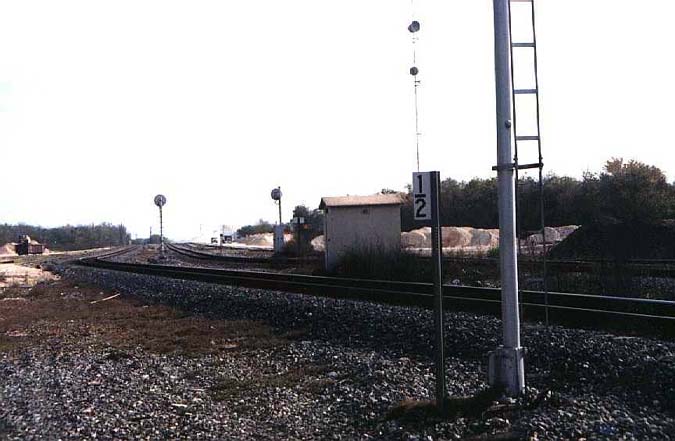
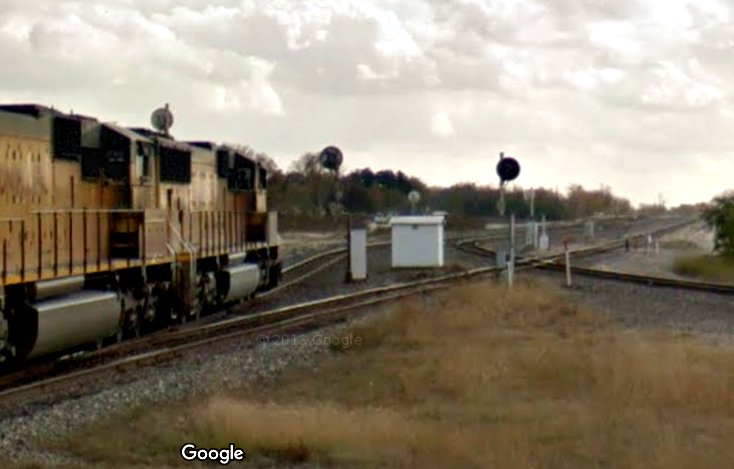
Above Left:
The cabinet hosting the automatic interlocking system for Tower 41 is near the
location where the tower sat. (Jim King photo, c.2000)
Above Right: This Google Street View image from 2012 shows a southbound UP
freight nearing the Tower 41 cabinet as it comes off of the former H&TC line and
switches onto the former I-GN line to Spring. The Santa Fe line from Somerville
enters the image at far right and crosses over the former H&TC line as it
curves south, parallel to the other two main lines. This
crossing was the impetus for the Tower 41 interlocker. Despite the proximity of
its tracks, the I-GN was not directly involved with the Tower 41 interlocker.
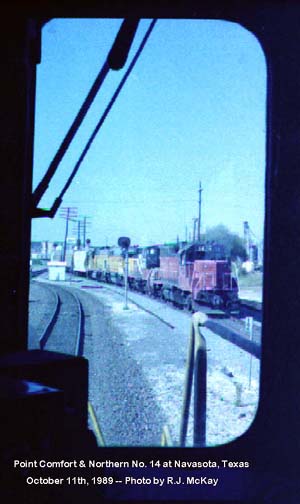 |
Left: An
engineer's view of the Tower 41 interlocking (R J McKay photo.) R
J writes about Tower 41:
"This crossing, especially in the direction we are going [on the Santa Fe],
and with a train going off on the old I&GN like the one in
the picture, can be a bit disconcerting at night when you are
tired and approaching it. On more than one occasion I have approached
this crossing with it having a green aspect on our signal, slowing
for the 10 MPH restriction over it. Suddenly I hear a horn blowing
repeatedly for the crossing in town, a bright headlight comes
around the curve, bearing down on us at 25 MPH. One begins to
second guess the green indication we have, then the train suddenly
curves off to your right and passes by! Had it proceeded on the
old SP, it would have crossed our path, and that is what runs
through your mind at the moment." |
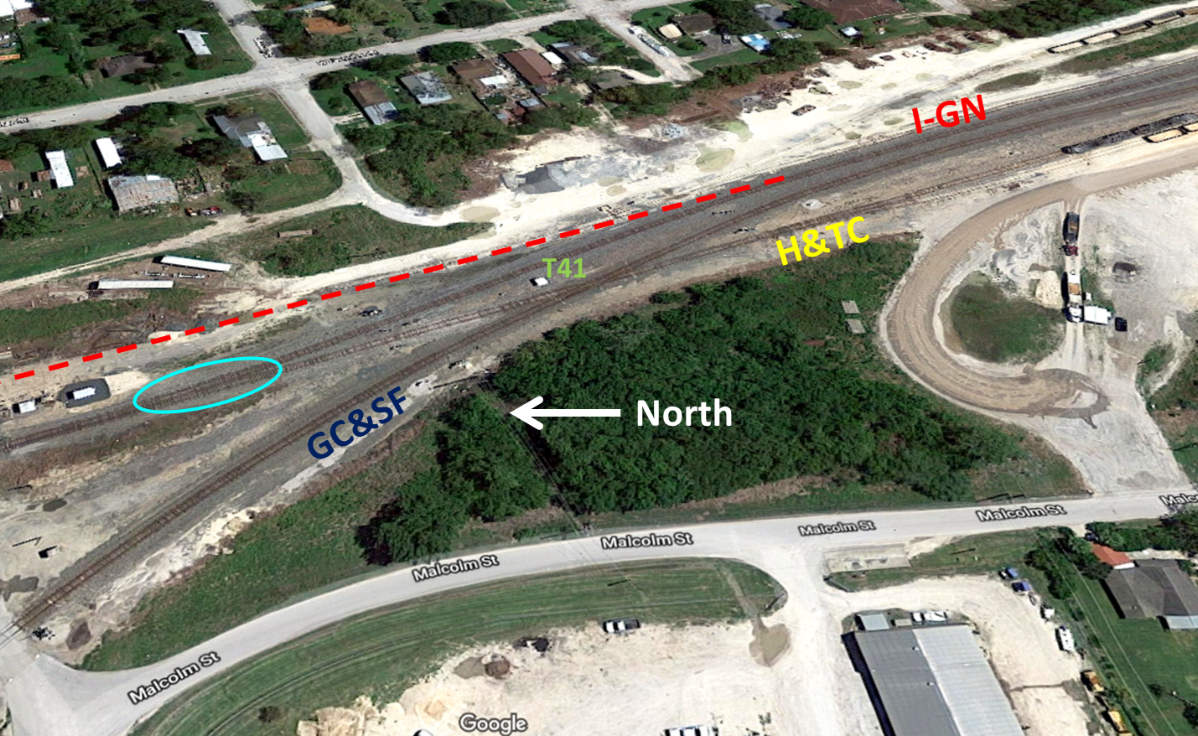
Above: When MP abandoned the
I-GN line between Navasota and College Station in 1965 and began using SP's H&TC
line to College Station, a switch (blue oval) was added to bring the former I-GN
tracks onto the H&TC, and the tracks north of there (red dashed line) were
removed. The new track from the switch to the I-GN main likely passed through
the spot where Tower 41 originally sat, but the tower was long gone by then. (Google Earth image, with
annotations)
Below Left: MP's straight track at Tower 9 was the branch to
Madisonville, and N. Railroad St. actually sits atop the former I-GN
grade. The curved line to College Station was the main line. To the
south, the H&TC line went to Hempstead and on to Houston while the I-GN line
went to Spring. (Google Earth image, with annotations) Below Right:
About 4 miles north of Navasota on the H&TC line, SP's Mexia-Nelleva Cutoff branched off due north toward
Mexia in 1907. Although the line was abandoned in 1933, the Navasota River
bridge abutments are still standing on the outskirts of Navasota, with the south
abutment casting a shadow into the river from the low sun in December, 2019.
Arguably, it should have been called the Mexia-Navasota Cutoff since Nelleva was
a tiny, unknown community on the edge of town. The Cutoff was not involved in
either of the Navasota towers, but the reason for its brief existence, and what
ultimately happened to it, is an interesting story.
(Google Earth image)
